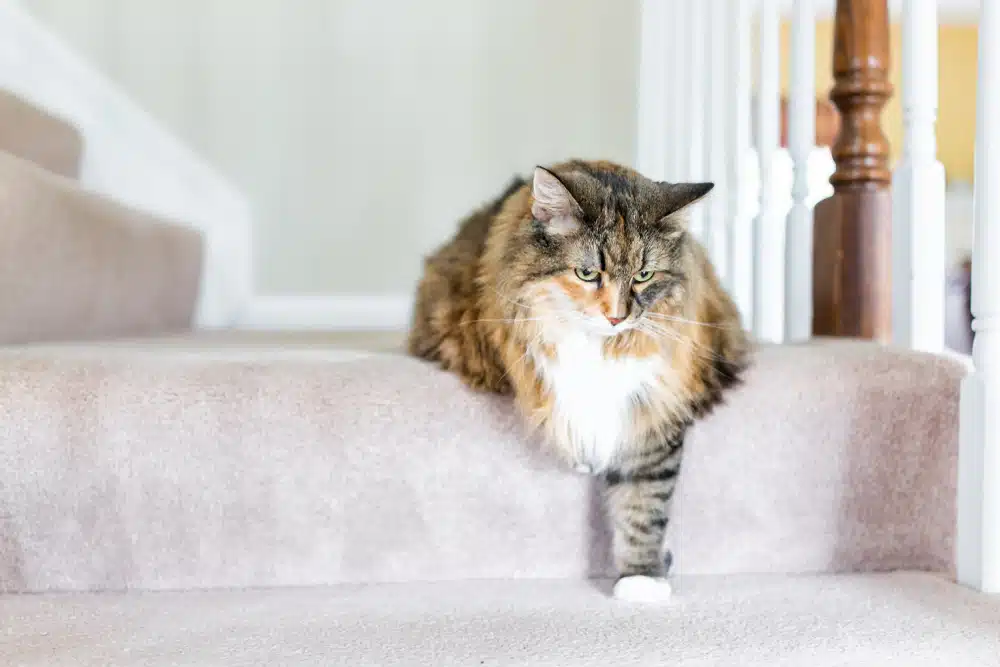Feline arthritis (i.e., degenerative joint disease) is a common condition affecting cats of all ages. This chronic inflammatory condition results in the breakdown of cartilage and other connective tissues within a cat’s joints, leading to pain, stiffness, and reduced mobility. Feline arthritis is a significant health concern that can greatly affect a cat’s quality of life. Our Animal Hospital of Parkland team explores feline arthritis causes, signs, diagnosis, and treatment.
Feline arthritis causes
A combination of genetic, environmental, and lifestyle factors cause feline arthritis. While cats of any age can develop the condition, based on their genetic predisposition, some cats have a higher risk of developing arthritis. Factors that can contribute to a cat’s arthritis development include:
- Age — Older cats are more susceptible to developing arthritis as a result of their joints’ wear and tear over time.
- Breed — Some cat breeds are more prone to developing arthritis than others, such as Maine coons, and Persian and Siamese cats.
- Weight — Overweight or obese cats are more likely to develop arthritis because of the increased pressure the extra pounds place on their joints.
- Health — Cats with certain medical conditions, such as diabetes or hyperthyroidism, may have an increased arthritis development risk.
- Joint injuries — Joint trauma, such as from a fall or accident, can increase a cat’s risk for arthritis development later in life.
- Infection —In rare cases, joint infections can cause a cat to develop arthritis.
Feline arthritis signs
Feline arthritis signs can be subtle and may develop gradually over time, making recognizing the condition a challenge in the disease’s early stages. Keep an eye out for these common feline arthritis signs:
- Limping or lameness — Cats with arthritis may exhibit a noticeable limp or favor the affected leg. They may also appear to be walking more slowly or hesitantly.
- Stiffness — Cats with arthritis may have difficulty moving their joints, particularly after rest or inactivity. They may appear to be stiff or slow as they get up and begin moving around.
- Difficulty jumping or climbing — Cats with arthritis may have difficulty jumping up onto furniture, climbing stairs, or engaging in other activities that require them to use their joints.
- Reduced activity level — Cats with arthritis may become less active and spend more time sleeping or resting. They may also appear less interested in playing or interacting with people, other pets, and their environment.
- Changes in grooming behavior — Cats with arthritis may have difficulty grooming themselves, particularly in hard-to-reach areas such as their back or hindquarters. They may also develop matted fur or appear unkempt.
- Loss of appetite — In some cases, cats with arthritis may have a reduced appetite or lose weight, which can be attributed to the condition’s pain and discomfort.
If your cat exhibits any of these signs, seek prompt veterinary care for a diagnosis and individualized treatment plan. Early intervention and treatment can help manage feline arthritis and improve your cat’s quality of life.
Feline arthritis diagnosis
To determine whether your cat has arthritis, your Animal Hospital of Parkland veterinarian will perform a thorough physical examination. Your veterinarian will look for the following:
- Lameness
- Gait, posture, or sitting position changes
- Difficulties sitting or getting up
- Swollen or thickened joints
- Crepitus (i.e., joint clicking sounds when moving)
- Pain on joint palpation
- Decreased joint range of motion
While a physical examination can indicate your cat has arthritis, X-rays and diagnostic testing are necessary for your veterinarian to make a definitive diagnosis and rule out underlying infection. X-rays enable your veterinarian to view your cat’s bones and joints, looking for the following abnormalities:
- Joint distention
- Bony outgrowths
- Soft tissue thickening
- Narrowed joint spaces
- Calcified free-floating bony lesions
Feline arthritis treatment
While arthritis cannot be reversed or cured, appropriate management can slow the progression and help relieve your cat’s pain, enabling them to lead a normal life. The most common and effective feline arthritis treatment approach is multimodal—in which multiple therapies are administered complementarily to provide a better outcome—and often includes:.
- Weight reduction — Extra pounds put extra strain on an overweight cat’s joints. Weight reduction is often the first step to take in easing an overweight arthritic cat’s joint strain.
- Solensia — Solensia is a new injectable medication for cats with arthritis, and we have seen great success with its use. Historically, there have been few treatment choices for cats with chronic pain, but this new medication provides an excellent option to keep arthritic cats comfortable and active.
- Nonsteroidal anti-inflammatories drugs (NSAIDs) — NSAIDs are great at relieving your affected cat’s pain and inflammation. However, this medication can have a significant effect on a cat’s internal organ function, and your veterinarian may recommend administering NSAIDs to your feline friend for only a specific period.
- Pain medications — Pain medications, such as gabapentin, are a good option for painful, arthritic cats, helping make them more comfortable.
- Joint supplements — Joint supplements that contain glucosamine hydrochloride and chondroitin sulfate can help reduce your arthritic cat’s pain, improve their joint function and mobility, and slow the condition’s progression.
- Injectable joint protectants — Monthly injectables that reduce arthritis pain are available, and for pet owners who do not want to administer medications daily, this treatment option is ideal.
- Alternative therapies — In addition to medication and supplements, an arthritic cat may benefit from alternative therapies such as acupuncture, and physical or cold laser therapies.
Left untreated, arthritis progresses and negatively impacts your cat’s quality of life. If you suspect your cat is suffering from arthritis, schedule an appointment with our Animal Hospital of Parkland team, so we can help minimize your feline friend’s discomfort.

